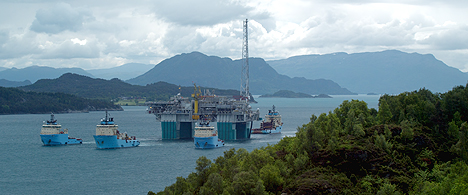
Towed by three large anchor-handling vessels, and with one following behind to steer, Gjøa was able to embark on its journey out to the field.
(Photo: Statoil)
“It feels incredibly good to finally send the platform out to the field. Many millions of work-hours lie behind this milestone,” acknowledges Statoil’s vice president for the Gjøa field development, Kjetel Digre.
Out in the fjord four huge anchor-handling vessels tautened the cables and the journey out to the field in the northern part of the North Sea commenced.
For work on Gjøa has not been without unexpected obstacles. An unusually long and snow-laden winter created a number of challenges for the project. And when spring finally arrived the platform tow had to be postponed.
A systematic review revealed that some minor modifications had to be carried out to the platform hull, and Gjøa had to remain in dock for an extended period.
“We have tackled a number of unforeseen hitches on the Gjøa project. So far we have solved all the challenges without delaying the planned start-up in the fourth quarter of 2010. This says a lot about what our project people are made of and it also speaks volumes about the need for having access to a competent specialist network, both in Statoil and at our suppliers,” states Digre.
Even though 70% of the work on Gjøa was carried out by Norwegian suppliers, the field development consists of pieces from all over the world.
“The gigantic jig-saw puzzle of these last five years has been solved thanks to an impressive cooperation between an incredible number of people, in Statoil and at our suppliers,” acknowledges Digre.
The tow out to the field is expected to take one and a half days. Work will then start on connecting the platform to the subsea installations and the pipelines that have already been made ready. Final trials and completion work, which can only be carried out on the field, will ensue before test production of oil and gas can start. It is expected that the field will come into regular production in the fourth quarter of 2010.
Gjøa will be the first floating platform to be supplied with electricity from shore. This will reduce environmental emissions equivalent to those from 100,000 passenger cars.
The field was proven in 1989 and its reserves are reckoned to amount to 82 million barrels of oil and condensate and 40 billion cubic metres of gas.
Statoil is development operator for the field while GDF SUEZ E&P Norge will take over as operator when Gjøa comes on stream.